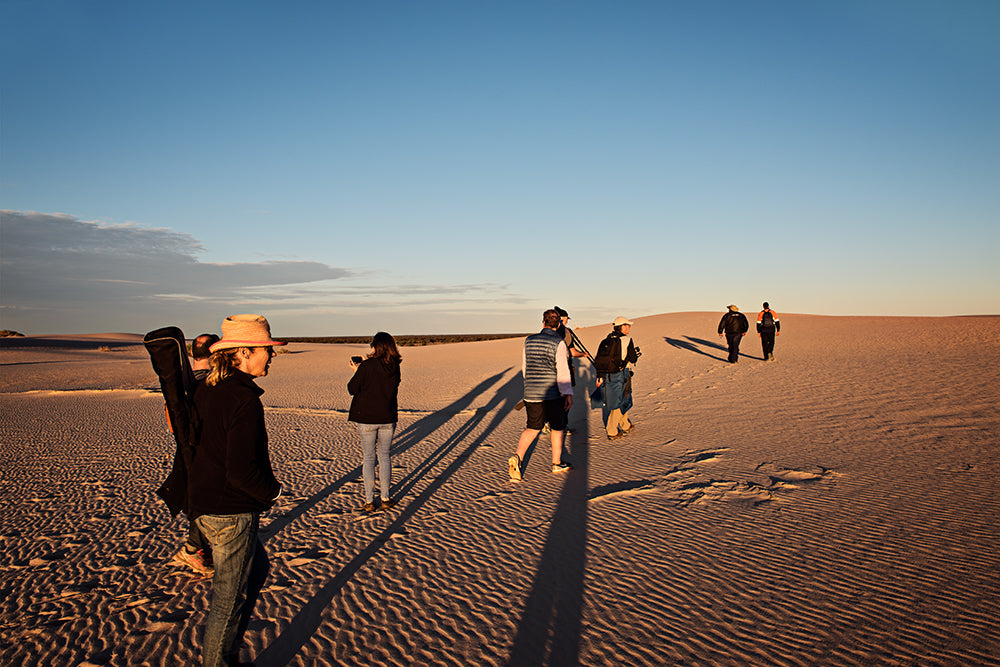Weekend at Mungo National Park

Copyright Millie Brown
For so many years I have wanted to visit Mungo national park after having seen photos my mother took there 15 years ago.
It has taken me quite some time! Finally I went and what a place it is! An extraordinary landscape with an extraordinary ancient history.

Copyright Millie Brown
The area known as Mungo National Park is one of the oldest known places outside of Africa to have been occupied by fully modern humans and is one of the most important archaeological sites in the world. The place where burials, campsites and artefacts of an ancient culture date back over 45,000 years.
A whole Aboriginal society lived here long before the Mayans and the pyramids existed. They performed wedding and funeral rituals, and lived in abundance.
And it is here in the Lunette dune system or the walls of China as it is sometimes knows (pic above) located on the eastern shoreline of what was Lake Mungo (which dried up approximately 18,000 years ago) that the remains of this ancient life can be found.
The Lunette runs for 30 kms and is made up of layers of sand and clay blown up from the lake, sand off the beach when the lake was brimming and clay from the lakebed when it was dry and salty.
The deposition of these 4 layers not only buried the debris of human activity but also ensured the remains could be dated by their surrounding sediment.
This makes the site so different form many other archaeological sites that contain a jumble of debris disrupted by erosion and other processes which make it hard to track the true sequence of events.

Copyright Millie Brown -

Copyright Millie Brown
It preserved thousands of ‘snapshots’ of indigenous life – a fireplace to cook fish or wallaby, a cluster of freshwater mussel shells left over after a meal or debris from the making of stone tools.

Copyright Millie Brown – remains of an ancient now extinct hairy nosed wombat

Copyright Millie Brown
Mungo Lady and Mungo Man
Over 40,000 years ago a young woman was burned and buried at the side of Lake Mungo, and in 1969 her burnt and broken bones were uncovered, put in a suitcase an taken to Canberra for research purposes. She was known back then as Mungo One, one quarter of her bones and three of her teeth survived.
The question of when she had lived had been a mystery until the invention of radio carbon dating in the USA not long after WWII.
Previously to the carbon dating of Mungo Lady as she came to be known it had been assumed that Aborigines were recent immigrants to the Australian landmass. It was assumed they had arrived not long before the birth of Christ.
Then a John Mulvaney from the University of Melbourne excavated a riverside cave near Mannum in South Australia to discover that it had been the home of Aborigines since about 3000 BC.

Copyright Millie Brown – a Chinese photo shoot!
Then 3 years later in central Queensland in the Kenniff Cave Mulvaney excavated evidence from former fireplaces showing that Aborigines had lived there even earlier. Pushing back their history another 10,000 years
Six years later Jim Bowler discovered Mungo Lady and the human history was pushed back even further again. The first radiocarbon tests on her bones showed the woman had lived around 24,000 years ago. It was then extended back to around 40,000 years ago after a period of further research.

Copyright Millie Brown – you will require a guide to take you out onto the Lunette
Mungo Man was discovered five years after Mungo Lady and no older man bones have been found in Australia since that time. Mungo Lady and Man are the earliest known human remains in the world today.
Mungo man had been sprinkled or anointed with red ochre, carried from an ironstone quarry very far away, here was the earliest evidence in the world of an important funeral rite: the cremation of a body.
The Aborigines, it was proclaimed, possessed the oldest living culture in the world.

Copyright Millie Brown

Copyright Millie Brown
Aboriginals have witnessed the setting of the sun on this land millions and millions of times.

Copyright Millie Brown – the moonscape at dusk
The land now existing as Mungo National Park once contained many pastoral properties (stations). Gol Gol station established in 1860 was one of the first.
To read more about the impact these grazing properties had on the indigenous people of this land and the history of the pastoralists and their stations click here.

Copyrighted Millie Brown – driving the red dirt roads of Mungo National park

Copyright Millie Brown – The old Mungo Station woodshed built in 1869 by Chinese workers and in its original condition
The woodshed and homestead are situated on the land that was once Lake Mungo.

Copyright Millie Brown – Interior of the Mungo station wool shed

Copyright Millie Brown – The Mungo station homestead

Copyright Millie Brown – signs showing the direction of all the pastoral stations that existed in the area

Copyright Millie Brown – picnic at a cool shady area on the self drive 70 km loop

Copyright Millie Brown – hiking the parks trails on what was the lake bed, with the eastern shoreline and lunette in the far distance. The woodshed and shearers quarters can also be seen.
We only had a few days at Mungo, it wasn’t long enough to fully discover it in all its beauty. I hope to return.
A note about accommodation, we stayed at the Shearers Quarters and loved it. A group of 5 rooms each with a number of beds (you book the room not the bed), clean, basic and with a communal kitchen, bbq area and big fire pit, its perfect and the closest accommodation to the lunette area. Handy for those early morning sunrises over the dunes. To book click here
If you don’t want to cook at the shearers Quarters Mungo Lodge with its restaurant is only 5kms down the dirt road, they also organise wonderful guided trips to the Lunette.
The return of Mungo Man
An exciting note to finish the post – this very weekend (in fact today, Friday the 17th November) the remains of Mungo Man will be returned to this land after having been at the National University of Canberra for the last four decades. He will finally be laid to rest in his rightful place and all will be as it should be.
Lady Mungo’s remains were returned to the area in 1992 and were locked away safely in the park until a safe reburial could take place.
The celebrations for the incredible and long awaited event will take place in the town of Mildura only couple of hours drive away from Mungo. It should be a joyful and big weekend.
Millie xx
